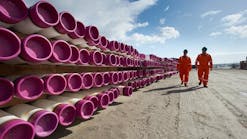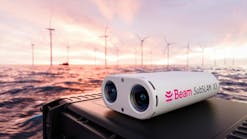Sweden: Caspian semi fitted with heavy duty mixers for high density muds
Maersk Contractors has purchased 17 submersible mud mixers from ITT Flygt to prevent settling in the irregular shaped tanks aboard a new semisubmersible drilling rig under construction in Singapore. The rig will be assembled in Baku and on completion in 2003, will operate in the Caspian Sea on a three-year drilling contract with Exxon Azerbaijan Operating Company LLC.
ITT Flygt's package comprised ten 11kW (15 hp) and seven 3.0 kW (4hp) explosion proof mixers. These were chosen in preference to traditional long shaft mixers which can have difficulty functioning well in irregularly shaped mud tanks. The company had worked with Maersk Contractors to solve a similar problem on the XL1 and XL2, the world's largest and most advanced harsh environment jack-ups.
Space restrictions on most rigs usually result in mud tanks being designed to fit into any area available. This can require them to be fabricated in highly irregular shapes that can inhibit good circulation of the mud needed to prevent settling. It was realized that if long shaft mixers were used under such conditions they would require motors twice the size of a Flygt submersible unit in order to achieve the same mixing capability. This would impose a higher level of energy consumption and, unlike the submersible mixers which are silent in operation, also create significantly higher noise levels, which can be very wearing for the rig crew. As each tank requires at least one mixer, traditional long shaft units can also take-up much valuable deck space because the motors are located over the tank where they also require expensive reinforced tank tops.
Sedimentation solution
The new Maersk drilling rig will have 17 mud tanks with a total volume of 687 cu m. Because of their irregular shapes and sizes most of the tanks have obstacles that can easily cause sedimentation problems. If this happens the mud can harden and become unusable, necessitating regular cleaning by crew members armed with shovels. Because submersible mud mixers can be positioned and angled anywhere in the tank, they have been found to overcome problems associated with sedimentation and are able to operate continuously to ensure that the mud maintains a workable consistency.
When the new rig enters service it will be the largest and most powerful in the Caspian Sea. It has been designed to operate in depths down to 1,000 meters and to drill in many different seabed formations.
The nature of the drilling operations planned imposes significant demands on the muds that will be used. Adequate mixing of the mud is essential as failure to maintain the correct chemical and physical properties in relation to the nature and condition of the seabed formation can lead to swelling of the formation clays. It can also lead to washing out of the hole, sticking of the drill string and casing, unsatisfactory cementation of the hole and, in extreme cases, an uncontrolled blowout of oil and gas. The demand will be even greater than usual due to the high densities of the muds to be used by Maersk. Two of the 17 tanks will contain mud with a density of SG 2.6 and the remainder will be used for mud with a density of SG 2.4.
For more information contact Robert Nyberg, ITT Flygt. Tel: +46 8 475 6000 /6714, Fax: +46 8 475 69 85, Email: [email protected].




